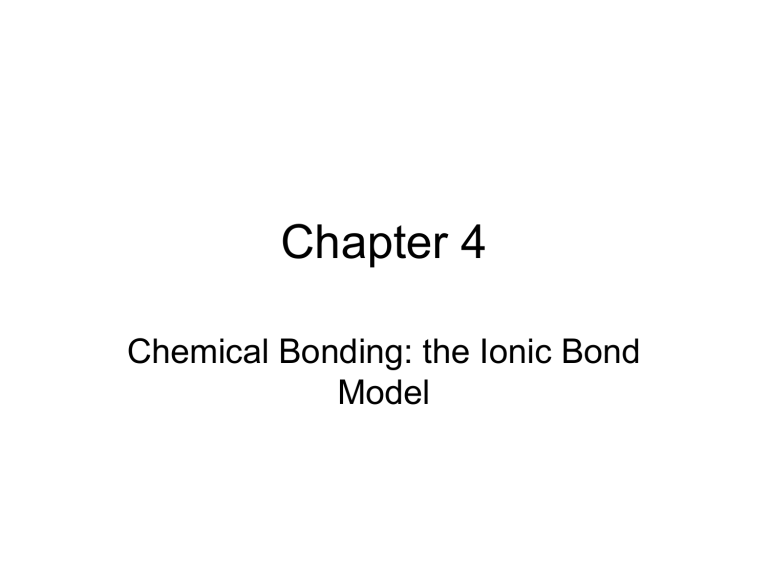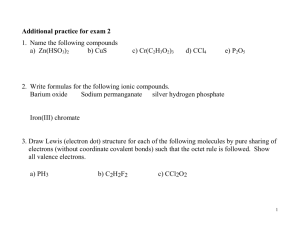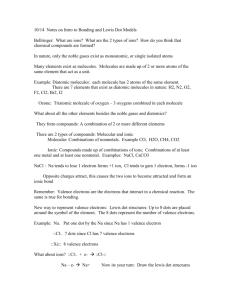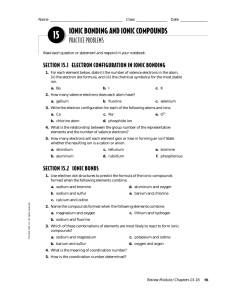Chapter 4

Chapter 4
Chemical Bonding: the Ionic Bond
Model
Chemical Bonds
• Atoms in chemical compounds are held together with bonds . The type of bond that does this depends on the type of compound.
• Two general types of compounds:
– Ionic – tend to exist as solids which have high melting points. Good conductors in the molten (liquid) state.
– Molecular – tend to exist as solids, liquids, and gases. Melting points are low relative to ionic compounds and they are not conductive in the molten state.
• Molecular compounds (e.g. H
2
O, C
6
H
12
O
6
, CH
3
OH) are found as distinct molecules, while ionic compounds (e.g. NaCl, KNO
3
, etc.) are found as parts of very large arrays of ions.
CO
2
Chemical Bonds
• A chemical bond is an attractive force that holds two or more atoms together in a more complex unit.
• Chemical bonds result from interactions between the electrons of neighboring atoms that combine to make these larger structures.
• In an ionic compound, ionic bonds are present, in which ions of opposite sign charges are attracted to each other.
• In molecular compounds, electrons are shared between atoms (usually this sharing is not equal) in covalent bonds .
H + H H-H
Chemical Bonds
• Two background concepts are important here, in understanding why bonds form between atoms as elements react: i.
Only some of the electrons on atoms are involved in chemical reactions. These electrons are the highest energy ones
(called valence electrons ) ii. Certain arrangements of electrons around atoms are more stable (and thus preferred), as explained by the octet rule
Valence electrons and Lewis symbols
• Valence electrons are the electrons that form bonds in chemical reactions. They are the electrons from an atom’s highest energy (highest numbered) electron shell.
• For example, for chlorine (Z = 17):
Cl: 1s 2 2s 2 2p 6 3 s 2 3 p 5
These are from shell #1
These are from shell #2
These are from shell # 3
(call this the valence shell )
Valence electrons and Lewis symbols
• For chlorine (a group 7A element), there are 7 valence electrons. The number of valence electrons for any group IA-VIIIA
(1A to 8A) element (called the
“ representative elements ”) will be the same as the element’s group number.
Lewis symbols
• A shorthand notation for representing an element and its valence electrons was proposed by G.N. Lewis: Lewis symbols.
• A Lewis symbol consists of an elemental symbol surrounded by the element’s valence electrons.
The valence electrons are represented by dots
(1 dot = 1 e ).
Lewis symbols
• In this system, the element’s symbol is surrounded by dots
(same number of dots as the valence electrons for that element) in a north-south-east-west fashion (see page 85-
86).
– Elements of the same group (from representative elements) have the same number of valence electrons (e.g. Li, Na, K each have one valence electron) – look at figure 4.1
– The number of valence electrons for a representative element is that element’s group number.
– The maximum number of valence electrons for any element is 8. Noble gases (Group VIII) each possess 8 valence electrons; helium (He) is an exception – it only possesses 2 valence electrons.
Drawing Lewis symbols
• Draw Lewis symbols for each of the following elements:
– Need to find the element in the periodic table
– Need to find the element’s group number
– Draw the symbol with the same number of dots around it as the element’s valence electrons
– Phosphorus
– Calcium
– Lead
– Iodine
– Argon
The octet rule
• Certain arrangements of electrons are more stable than others. For example, the noble gases are very stable elements (each having eight valence electrons).
• When atoms participate in chemical reactions, they tend to do so in ways that will give them eight valence electrons * (the “ octet rule ”).
They can do this either by: i.
sharing electrons with other atoms, or ii.
by giving away electrons to other atoms/taking electrons from other atoms
Eight valence electrons corresponds to completely filled s and p subshells in the highest electron shell
* Again, the exception is helium, which is very stable and has only two valence electrons
The ionic bond model
• Ions are atoms that have lost or gained electrons, producing charged species
• Remember, atoms are neutral because they have the same numbers of protons (+) and electrons (-); ions have different numbers of protons and electrons (and so they are charged).
• For example a chlorine ion has 17 protons and 18 electrons (so net charge of -1)
Cl -
• A sodium ion has 11 protons and only 10 electrons
(net charge of +1) Na +
The ionic bond model
• So you can calculate an ion’s charge by summing the charges of the protons and electrons.
• In cases where ions carry multiple charges:
Mg 2+ : 12 protons and 10 electrons
Al 3+ : 13 protons and 10 electrons
S 2: 16 protons and 18 electrons
N 3: 7 protons and 10 electrons
The sign and magnitude of ionic charge
• In using the octet rule to predict the nature of an ion, the periodic table is useful.
• When ionic compounds are formed , atoms will tend to gain or lose electrons until they possess the same number of electrons as the nearest-neighbor noble gas.
• Example: for sodium, Na, losing 1 e makes a Na + ion noble gases
Na
If a sodium atom were to lose one electron, it would have the same number of electrons as neon (Ne) a noble gas
The sign and magnitude of ionic charge
• When a chlorine molecule reacts with sodium to form an ionic compound (NaCl), it picks up an electron (and is tranformed to a chloride ion, Cl ).
• Chlorine’s nearest-neighbor noble gas is argon (Ar).
Cl noble gases
The sign and magnitude of ionic charge
• When ionic compounds are formed, they are usually formed from reactions that involve metals and non-metals.
– Metals from groups 1A, 2A, and 3 A tend to lose 1,
2, and 3 electron(s) , respectively, to get the same number as the nearest-neighbor noble gas (forming ions of +1, +2, and +3 charge).
– Non-metals from groups 5A, 6A, and 7A tend to gain
3, 2, and 1 electron(s) to get the same number as the nearest-neighbor noble gas, forming ions that have -
3, -2, and -1, respectively.
– Elements from goup 4A tend to form covalent bonds
(see next chapter).
The sign and magnitude of ionic charge
Writing electron configurations of ions and shorthand notation
• You can use the periodic table to abbreviate an electron configuration for an element or ion, by using a noble gas to account for part of that electron configuration
• Example: sodium (Na) is 1s 2 2s 2 2p 6 3s 1 , or just [Ne] 3s 1
• For an ion, like Na + , it would be 1s 2 2s 2 2p 6 or just [Ne]
For Cl: 1s 2 2s 2 2p 6 3s 2 3p 5 or
[Ne]3s 2 3p 5
O 2: 1s 2 2s 2 2p 6
Or
[Ne]
Isoelectronic species
• Isoelectronic is a term that means having the same number and configuration of electrons.
• For example: O 2, F , Ne, and Na + :
All of these species have the same electron configuration
1s 2 2s 2 2p 6
O 2-
F -
Ne
Na +
Z
8
9
10
11 protons electrons
8
9
10
11
10
10
10
10 charge
-2
-1
0
+1
Lewis structures for ionic compounds
• When ionic compounds are formed, one atom (or group of atoms) loses an electron and the other atom (or group of atoms) takes them. This can be represented by Lewis structures:
Should enclose the Lewis symbol for an ion in square brackets, with charge indicated to the upper right
Lewis structures for ionic compounds
Lewis structures for ionic compounds
Calcium is group 2A
Chlorine is group 7A
Chemical formulas for ionic compounds
3(+2) + 2(-3) = 0
• Because formulas for compound are neutral (e.g. NaCl (Na + Cl ) overall has no charge), one can determine the formula of a compound this way:
– The charge on the positive ion becomes the subscript on the negative ion.
– The charge on the negative ion becomes the subscript on the positive ion.
– If these subscripts are not in the lowest whole-number ratio, divide them by the greatest common factor.
Hints:
- Symbol for the positive ion is always written first
- Charges are not shown in the formula for the compound
- Subscripts give the combining ratios for the ions
The structure of ionic compounds
• In an ionic compound, ions are surrounded by ions of opposite charge in a lattice structure
• The smallest part of that lattice that expresses the chemical formula of the ionic compound is called the formula unit .
Recognizing and naming binary ionic compounds
• Binary compounds possess only two elements in their formulas (e.g. NaCl, NH
3
, P
2
O
5
)
• In binary ionic compounds , one element is a metal and the other is a non-metal (e.g. MgCl
2
Fe
2
O
3
)
,
• In naming binary ionic compounds, the metal’s name is given first, followed by the non metal part. The non-metals name is presented as a stem (first part of the element’s name) with the suffix –”ide”
NaCl: sodium chloride
K
3
N: potassium nitride
K
2
O: potassium oxide
Recognizing and naming binary ionic compounds
• For binary ionic compounds involving transition metals, the charge of the transition metal is indicated with Roman numerals in brackets.
• Examples:
– AuCl
3
: gold(III) chloride
– AuCl: gold(I) chloride
– FeBr
2
: iron(II) bromide
– Cu
2
S: copper(I) sulfide
The charge of the metal in these cases can be determined from the charge that must exist on the non-metal
2(charge on Cu) + charge on sulfide = 0
2(charge on each Cu) + -2 = 0 charge on each Cu = +1
Polyatomic ions
• Monatomic ions are ions that are derived from single atoms, by loss or gain of electrons.
• Polyatomic ions are groups of atoms that carry a charge overall, as a group. These atoms are held together (as a polyatomic ion) through covalent bonds.
• Examples:
– Sulfate: SO
4
2-
– Carbonate: CO
3
2-
– Acetate: C
2
H
3
O
2
-
– Hydroxide: OH -
– Ammonium: NH
4
+
– Hydronium: H
3
O +
Chemical formulas for ionic compounds containing polyatomic ions
• Two situations not previously encountered in naming come up when polyatomic ions are involved:
– When more than one polyatmoic ion of a given type is present in a formula, the ion is surrounded with brackets. The subscript, which indicates how many of these ions are present, is placed outside the brackets.
Example: ammonium oxide: (NH
4
)
2
O
– The same elemental symbol may appear more than once in a formula, when polyatomic ions are involved.
For example, ammonium nitrate: N H
4
N O
3
Convention: the positive polyatomic ion is treated like a metal ion (positive) in naming
– it appears first, before the negative ion’s name.
Give formulas for the following ionic compounds
• Ammonium fluoride
• Nickel(II) acetate
• Iron(III) oxide
• Sodium phosphate


![unit_3_part_2_prezi_pp[1]](http://s3.studylib.net/store/data/009491974_1-00bf7ba85f40f2a9d20b42cbbebf0ab5-300x300.png)




